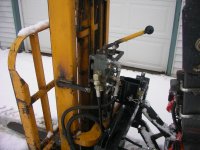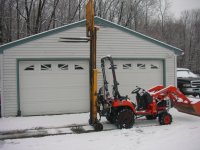uncaged
New member
I'm trying to figure out how to pull some hydraulics off a dead forklift to use on my Kubota with rear remotes and was hoping I could get some help in understanding how it's plumbed. I've attached a sketch of how it's plumbed, for a visual.
The forklift has a valve that raises the mast, and another valve that angles the mast, both are Parker VDP valves. The angle valve looks to be like a normal DA cylinder valve. The mast valve is a little funky. Well, first, there is what looks to be 2 pumps running piggyback off the same shaft. A small pump and a big pump. The "out" of the small pump runs to the angle valve and the "out" of the big pump runs to the mast valve.
One thing I don't understand, is that a line runs from the angle valve to the mast valve. Why is this? Why wouldn't it return to the tank? The mast valve already has a pressure line running to it.
What is the reasoning behind the 2 pumps running 2 separate lines to each of the valves?
How would I plumb this to run from one supply line?
How much pressure is on the line that comes out of the mast valve and goes to the filter? It can't be much, and where did the pressure go that was supplying the valve?
Sorry for so many questions, I'm soaking up as much as I can as fast as I can.
Thanks!
The forklift has a valve that raises the mast, and another valve that angles the mast, both are Parker VDP valves. The angle valve looks to be like a normal DA cylinder valve. The mast valve is a little funky. Well, first, there is what looks to be 2 pumps running piggyback off the same shaft. A small pump and a big pump. The "out" of the small pump runs to the angle valve and the "out" of the big pump runs to the mast valve.
One thing I don't understand, is that a line runs from the angle valve to the mast valve. Why is this? Why wouldn't it return to the tank? The mast valve already has a pressure line running to it.
What is the reasoning behind the 2 pumps running 2 separate lines to each of the valves?
How would I plumb this to run from one supply line?
How much pressure is on the line that comes out of the mast valve and goes to the filter? It can't be much, and where did the pressure go that was supplying the valve?
Sorry for so many questions, I'm soaking up as much as I can as fast as I can.
Thanks!


